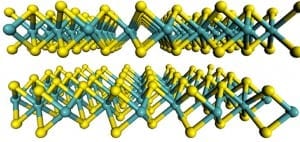In the future, it could also enable entirely new kinds of devices.
MIT researchers produce complex electronic circuits from molybdenum disulfide, a material that could have many more applications.
The discovery of graphene, a material just one atom thick and possessing exceptional strength and other novel properties, started an avalanche of research around its use for everything from electronics to optics to structural materials. But new research suggests that was just the beginning: A whole family of two-dimensional materials may open up even broader possibilities for applications that could change many aspects of modern life.
The latest “new” material, molybdenum disulfide (MoS2) — which has actually been used for decades, but not in its 2-D form — was first described just a year ago by researchers in Switzerland. But in that year, researchers at MIT — who struggled for several years to build electronic circuits out of graphene with very limited results (except for radio-frequency applications) — have already succeeded in making a variety of electronic components from MoS2. They say the material could help usher in radically new products, from whole walls that glow to clothing with embedded electronics to glasses with built-in display screens.
A report on the production of complex electronic circuits from the new material was published online this month in the journal Nano Letters; the paper is authored by Han Wang and Lili Yu, graduate students in the Department of Electrical Engineering and Computer Science (EECS); Tomás Palacios, the Emmanuel E. Landsman Associate Professor of EECS; and others at MIT and elsewhere.
Palacios says he thinks graphene and MoS2 are just the beginning of a new realm of research on two-dimensional materials. “It’s the most exciting time for electronics in the last 20 or 30 years,” he says. “It’s opening up the door to a completely new domain of electronic materials and devices.”
Like graphene, itself a 2-D form of graphite, molybdenum disulfide has been used for many years as an industrial lubricant. But it had never been seen as a 2-D platform for electronic devices until last year, when scientists at the Swiss university EPFL produced a transistor on the material.
MIT researchers quickly swung into action: Yi-Hsien Lee, a postdoc in associate professor Jing Kong’s group in EECS, found a good way to make large sheets of the material using a chemical vapor deposition process. Lee came up with this method while working with Lain-Jong Li at Academia Sinica in Taiwan and improved it after coming to MIT. Palacios, Wang and Yu then set to producing building blocks of electronic circuits on the sheets made by Lee, as well as on MoS2 flakes produced by a mechanical method, which were used for the work described in the new paper.
Wang had been struggling to build circuits on graphene for his doctoral thesis research, but found it much easier to do with the new material. There was a “hefty bottleneck” to making progress with graphene, he explains, because that material lacks a bandgap — the key property that makes it possible to create transistors, the basic component of logic and memory circuits. While graphene needs to be modified in exacting ways in order to create a bandgap, MoS2just naturally comes with one.
The lack of a bandgap, Wang explains, means that with a switch made of graphene, “you can turn it on, but you can’t turn it off. That means you can’t do digital logic.” So people have for years been searching for a material that shares some of graphene’s extraordinary properties, but also has this missing quality — as molybdenum disulfide does.
Because it already is widely produced as a lubricant, and thanks to ongoing work at MIT and other labs on making it into large sheets, scaling up production of the material for practical uses should be much easier than with other new materials, Wang and Palacios say.
via MIT – David L. Chandler
The Latest Streaming News: Layered semiconductors updated minute-by-minute
Bookmark this page and come back often
Latest NEWS
Latest VIDEO









